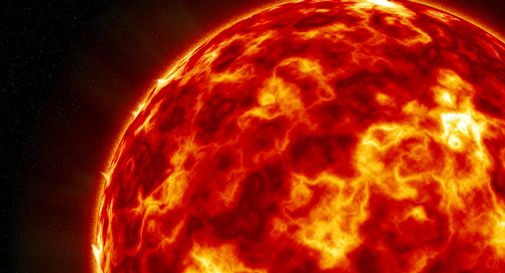Un'età d'oro dell'esplorazione solare
Tre nuovi strumenti per svelare i segreti della nostra stella di casa, il Sole
| Richard Brewer |

Questa è stata chiamata "l'età dell'oro" dell'esplorazione solare con il debutto di tre nuovi strumenti per rivelare i segreti della nostra stella natale, il Sole: Il telescopio solare Inouye a 3.000 metri sul livello del mare sul monte. Haleakala ("Casa del Sole") Maui, Hawaii, raccoglierà più informazioni sulla nostra stella nei prossimi cinque anni rispetto a tutti i dati solari raccolti da quando Galileo ha puntato per la prima volta un telescopio verso il Sole nel 1612. Il loro primo ad alta risoluzione basato su terra l'immagine di una macchia solare è stata rilasciata il 3 dicembre 2020.
Il Solar Orbiter lanciato il 9 febbraio 2020 fornirà il nostro primo sguardo in assoluto ai poli del Sole per scoprire l'origine di violente tempeste solari e venti solari che inviano materiali carichi verso la Terra a velocità superiori a 1,6 milioni di km / h.
La Parker Solar Probe è la prima volta che l'umanità visita una stella, che tocca il nostro sole volando più vicino di qualsiasi veicolo spaziale precedente. Nel 2019 è volato attraverso la tenue atmosfera solare a soli 24 milioni di km (arrivando infine a 6 milioni di km entro il 2024), per misurare direttamente la fonte di "Space Weather", il flusso supersonico di particelle cariche e brillamenti solari emessi dal superficie solare. I dati del 2020 di Parker ci hanno aiutato a comprendere meglio le loro origini magnetiche.
Un sole magnetico? Sorprendentemente, i campi magnetici sono onnipresenti nello spazio, circondano i pianeti, permeano la Via Lattea e dominano il nostro Sole.
Nato 4,5678 miliardi di anni fa da una nuvola di gas e polvere magnetizzati che ruotano lentamente che è collassata sotto la sua stessa gravità e forze magnetiche, il Sole è una stella magnetica infilata da un groviglio di linee di campo magnetico che incanalano materiale caricato elettricamente. Il nostro Sole ha un campo magnetico molto, molto forte che è responsabile di tutta l'attività solare che vediamo. Maltempo in Veneto questo mese… Tutto il tempo sulla Terra, dalla sua superficie nello spazio, inizia con il Sole. Sia il tempo che percepiamo in superficie, sia il "tempo spaziale" e le tempeste magnetiche sul Sole sono influenzati da piccoli cambiamenti nelle regioni magnetizzate chiamate macchie solari durante un ciclo solare di 11 anni. Macchie solari, inizia un nuovo ciclo magnetico: con la scoperta che le macchie solari sono tubi di magnetismo (vedi immagine sotto), è diventato chiaro che il ciclo delle macchie solari di 11 anni è in realtà magnetico.
Il numero di macchie solari indica un aumento dell'attività solare ei cicli sono stati fatti risalire al 1755, che è stato designato come ciclo 1. Dopo aver raggiunto un punto minimo nel 2019 con un minimo solare lungo e una faccia priva di macchie solari per 780 giorni, il Sole sta ora iniziando verso il suo prossimo massimo solare.
L'8 gennaio 2020 è stata osservata l'emergere di una nuova macchia solare, iniziando così il ciclo solare 25. Il "tempo spaziale" è dovuto a un flusso di materiale carico chiamato vento solare. Le regioni magneticamente attive nell'atmosfera del Sole, che chiamiamo corona solare, possono improvvisamente esplodere rilasciando più energia di 10 miliardi di bombe atomiche. 1,4 miliardi di kg di materiale solare vengono lanciati nello spazio a centinaia di chilometri al secondo portando con sé porzioni del campo magnetico del sole. Questi eventi si fanno sentire non solo sulla Terra, ma sono stati persino rilevati miliardi di km nello spazio interstellare dalla sonda Voyager. Gli eventi meteorologici spaziali possono influire sull'energia elettrica della Terra (sovratensioni nelle correnti indotte causano massicci guasti alla rete), sistemi di navigazione (con una perdita di GPS), aviazione (con perdita di comunicazione e navigazione inaffidabile), comunicazioni (con guasto dei componenti elettronici) e Operazioni satellitari (con guasto dei componenti elettronici) e umani nello spazio (a causa di rischi di radiazioni e guasti del sistema). Le tempeste solari sono la fonte delle aurore stranamente belle che vediamo vicino ai poli della Terra mentre le particelle ad alta energia del sole colpiscono l'atmosfera terrestre.
Solo negli ultimi 50 anni abbiamo imparato che il campo magnetico della Terra ci protegge dalla radiazione solare letale e poiché la Luna ha perso il suo scudo magnetico e Marte ne ha solo uno debole, la capacità di prevedere il tempo solare e le tempeste è importante per proteggere gli esseri umani. ritornare sulla Luna o andare su Marte. La radiazione solare è anche la fonte energetica di base del clima qui sulla Terra e il clima è di fondamentale importanza per noi. Capire come il Sole influisce sulla Terra è fondamentale per capire come il clima è variato in passato e come potrebbe cambiare in futuro. Alcuni segreti del nostro Sole sono rivelati non solo dalle nostre sonde e telescopi solari, ma esaminando le rocce restituite dalla crosta lunare. Il suolo lunare raccolto da Apollo e più recentemente dalla sonda cinese Chang'e 5, è bombardato dal vento solare e immagazzina miliardi di anni di storia del Sole rendendo possibile determinare come l'attività del Sole sia cambiata nel tempo e il suo impatto sul clima terrestre. I prossimi cinque anni dovrebbero fornire progressi scientifici rivoluzionari nella scienza solare e la nostra comprensione dell'enorme, bella e in costante cambiamento fonte di tutta la vita sulla Terra, il Sole.
A Golden Age of Solar Exploration
Three new tools to reveal the secrets of our home star, the Sun
This has been called the “Golden Age” of Solar exploration with the debut of three new tools to reveal the secrets of our home star the Sun: The Inouye Solar Telescope 3,000 meters above sea level on Mt. Haleakala (“House of the Sun”) Maui, Hawaii, will collect more information about our home star in the next five years than all the solar data gathered since Galileo first pointed a telescope at the Sun in 1612. Their first high resolution ground based image of a sunspot was released 3 December 2020.
The Solar Orbiter launched 9 February 2020 will provide our first ever look at the the Sun’s poles to uncover the origin of violent solar storms and solar winds that send charged materials toward Earth at speeds exceeding 1.6 million km/hr.
The Parker Solar Probe is humanity’s first visit to a star, touching our sun by flying closer than any previous spacecraft. In 2019 it soared through the tenuous solar atmosphere at only 24 million km (eventually coming as close as 6 million km by 2024), to directly measure the source of “Space Weather,” the supersonic stream of charged particles and solar flares emitted from the solar surface. The 2020 data from Parker has helped us better understand their magnetic origins.
A magnetic Sun? Surprisingly, magnetic fields are omnipresent in space, surrounding planets, permeating the Milky Way and dominating our own Sun. Born 4.5678 billion years ago from a slowly spinning cloud of magnetized gas and dust that collapsed under its own gravity and magnetic forces, the Sun is a magnetic star threaded by a tangle of magnetic field lines that channel electrically charged material. Our Sun has a very, very strong magnetic field that is responsible for all the solar activity we see.
Maltempo in Veneto this month … All weather on Earth, from its surface out into space, begins with the Sun. Both the weather we feel at the surface as well as “Space weather” and magnetic storms on the Sun are influenced by small changes in magnetized regions called sunspots during an 11 year solar cycle. Sunspots, a new magnetic cycle begins: With the discovery that sunspots are tubes of magnetism (see image below), it became clear that the 11 year solar sunspot cycle is actually a magnetic one. The number of sunspots indicate increased solar activity and the cycles have been traced back to 1755 which was designated cycle 1. After reaching a low point in 2019 with a long solar minimum and a face free of sunspots for 780 days, the Sun is now starting towards its next solar maximum. On 8 January 2020, a new sunspot was seen emerging, thus beginning Solar cycle 25. “Space weather” is due to a stream of charged material called the solar wind. Magnetically active regions in the Sun’s atmosphere that we call the solar corona, can suddenly erupt releasing more energy than 10 billion atomic bombs. 1.4 billion kg of solar material is flung into space at hundreds of kilometers per second carrying with it portions of the sun’s magnetic field.These events are felt not only on Earth but have even been detected billions of km into interstellar space by the Voyager spacecraft.
Space weather events can impact Earth’s Electric power (surges in induced currents cause massive network failures), Navigation Systems (with a loss of GPS), Aviation (with communications loss and unreliable navigation), Communications (with failure of electronic components) as well as Satellite Operations (with failure of electronic components), and Humans in space (due to radiation hazards and system failures). Solar storms are the source of the eerily beautiful Auroras we see near the Earth’s poles as high energy particles from the sun strike Earth’s atmosphere. Only in the past 50 years have we learned the Earth’s own magnetic field shields us from lethal solar radiation and since the Moon has lost its magnetic shield and Mars has only a weak one, the ability to forecast solar weather and storms is important to protect humans returning to the Moon or going to Mars.
Solar radiation is also the basic energy source of climate here on Earth and climate is of fundamental importance to us. Understanding how the Sun affects Earth is basic to understanding how climate has varied in the past and how it might change in the future. Some secrets of our Sun are revealed not only by our solar probes and telescopes, but by examining rocks returned from the Moon’s crust. The lunar soil collected by Apollo and more recently by the Chinese Chang’e 5 probe, are bombarded by the solar wind and stores billions of years of the Sun’s history making it possible to determine just how the Sun’s activity has changed over time and its impact on Earth’s climate.
The next five years should provide breakthrough scientific advances in solar science and our understanding of the huge, beautiful and constantly changing source of all life on Earth, the Sun.








